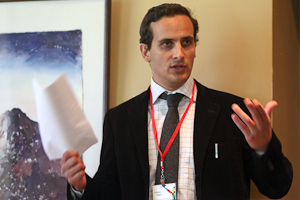Frédéric Mégret, Associate Professor of Law and Canada Research Chair in the Law of Human Rights and Legal Pluralism at McGill

“These days, the battlefield hardly seems to be a term of art in international humanitarian law discourse… Certainly, the idea of disciplined armies meeting in a rural setting at dawn to fight each other off belongs to distant memories.”
So begins Frédéric Mégret’s recent journal publication, “War and the Vanishing Battlefield,” in the Loyola University Chicago International Law Review, Vol. 9, No. 1, 2012, which examines the role of the battlefield as a regulatory concept in the laws of war. Examining the post 9/11 redefinitions of the battlefield, as well as the deconstruction of the concept prior to 9/11, Mégret argues that the idea of the battlefield continues to haunt our concept of what war entails.
In fact, he argues, such redefinition and deconstruction are eroding the normative power of the laws of war, and threaten to obscure the differences between war and a reign of arbitrary violence.
Richard Gold, James McGill Professor of Law and associate member of the Department of Human Genetics at McGill
In a court case that has engendered much discussion among ethicists and the biotechnology industry, Myriad Genetics is seeking to protect its patents on two human genes used to predict if women have an increased risk of getting breast or ovarian cancer. The U.S. Supreme Court is currently receiving petitions for a writ of certiorari to hear the case. Petitioners include the American Civil Liberties Union, as well as an international group of legal and medical scholars, who, with Richard Gold as lead author, similarly filed an amici curiae brief with the court in early 2012.
Gold, who has authored an extensive case study of Myriad Genetics and its patenting policies, argued, along with his fellow amici curiae, that the Federal Circuit ruling on the case incorrectly introduced a scientifically incoherent test for patentability under Section 101 of the United States patents code. This could introduce confusion and uncertainty not only in the field of human clinical genetics, the authors warn, but also across the life sciences generally.
Colleen Sheppard, Professor of Law and Director of the Centre for Human Rights and Legal Pluralism at McGill
Disrimination occurs along many vectors, such as gender, race, ethnicity, disability, age, religion, sexual orientation and social class. What happens when an individual is faced with more than one form of grounds-based discrimination — multiple discrimination — at the same time?
In her working paper, “Multiple Discrimination in the World of Work,” published by the International Labour Organization, Colleen Sheppard states that while multiple discrimination has always existed, it has not always been recognized as a legal concept.
“African-American women first spoke out about the ways in which single ground approaches to anti-discrimination law failed to capture the lived realities of inequalities linked to gender, race and ethnicity,” she says. Now, many forms of multiple discrimination are becoming more widely recognized and contribute to the multidimensional and complex character of discrimination.
Her paper examines continuing challenges in recent legal and policy developments for recognition of claims of multiple discrimination and identifies several strategies, including participatory approaches to workplace governance and the introduction of government initiatives aimed at securing decent work, to take the phenomenon of multiple discrimination into account.
